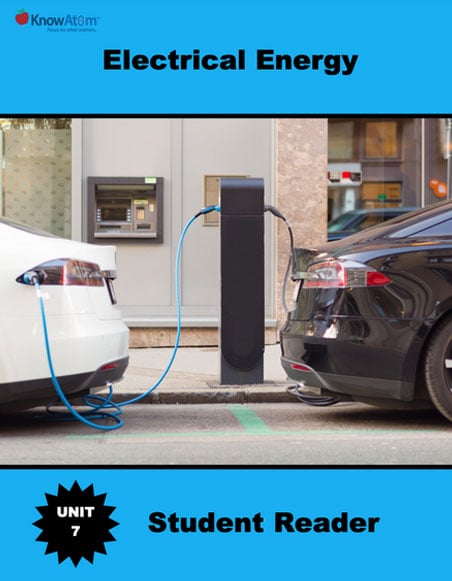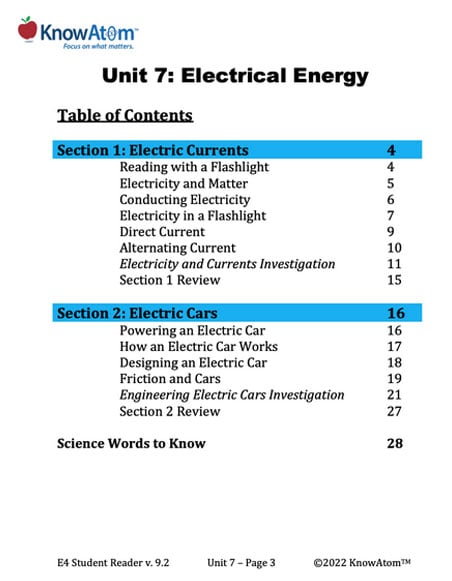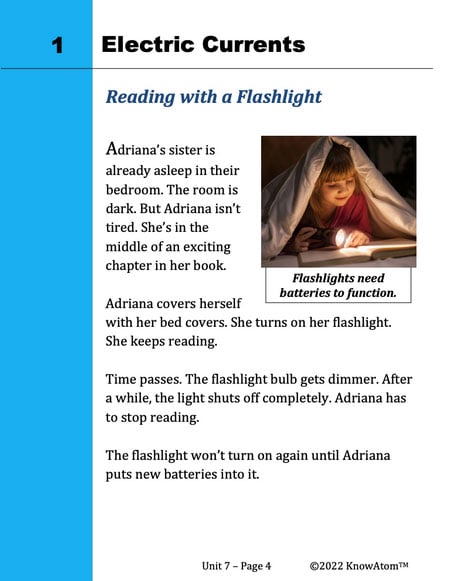Science background provides teachers with more in-depth information about the phenomena students explore in this unit. Below is an excerpt from the science background on electric cars.
Electric cars are designed to reduce the need for fossil fuels such as gasoline or diesel because they run entirely on electricity, using rechargeable batteries that store chemical energy.
Understanding electricity begins with the structure of matter. Remember that all matter is made of atoms, which are the smallest pieces of matter that have the properties of an element. Atoms are so tiny that we cannot see them.
Atoms themselves are made up of smaller particles, called protons, neutrons, and electrons. Electrons have a negative charge (-) and are attracted to positively charged protons (+). The force that holds protons and electrons together in an atom is called electromagnetic force. It occurs whenever particles are charged, causing them to either attract or repel one another.
Particles that have an opposite charge attract one another, while particles with the same charge repel each other. Electrons are kept in orbit in their shells because the positive charge of the protons in the nucleus attracts the negatively charged electrons.
Protons repel each other in the nucleus because they all have a positive charge, but they stay together because of another force, called the strong force. The strong force counters the electromagnetic force because it is the strongest attractive force, 137 times more powerful than the electromagnetic force. However, it only exerts a force over very short distances, and so it does not exert a force over electrons.
Electrons that are in shells closest to the nucleus are tightly bound to the protons because of the electromagnetic force. Just like the strong force, the electromagnetic force weakens with distance, so electrons in the outermost shell are much more loosely bound. When a force is applied such as by a battery, those farther electrons can be pushed from one atom to another in certain kinds of matter.
Electrons can move more easily through some kinds of materials than others. Materials that allow electrons to pass through are called electrical conductors. Metals are common conductors. Silver, copper, bronze, and aluminum are all metals and good conductors.
Some materials don’t allow electrons to pass through as easily. These materials are called electrical insulators. Glass, rubber, plastic, and ceramic are all good insulators. When electrons flow through a conductor, it produces electricity. Electronic devices direct electricity through the wires of a circuit, which is the circular path electrons travel from a negative charge to a positive charge.
Circuits are used to transfer energy from one place to another. The electrons are first pushed through a wire by a power source, such as a battery or electrical generator. It’s important to note that the energy source doesn’t store the electrons. Instead, it provides the force that pushes the electrons in the conductive material through the circuit.
From there, the electric current (flow of charged particles) travels through the wire until it reaches an object or objects that can do work. For example, a passing electric current transfers electrical energy to a light bulb, where the energy is converted to light energy and heat. The electrical current then travels down a second wire back to the power source. The entire circuit forms a circular loop. The word “circuit” means “circle.”
All vehicles are designed with circuits to connect the energy source with the motor. In an electric car, the electric motor is part of a circuit that includes a power source such as a rechargeable battery. The motor spins when the circuit is closed and the electrical energy is converted into kinetic energy. This spinning provides an unbalanced force that makes the car move. The motor is connected to an axle using gears. Wheels attached to the axle spin when the axle spins. Every part on the vehicle, including its wheels, axles, motor, and gears, is placed in a specific location to balance the weight of the car.
All objects have a point inside them that is their center of gravity. Imagine trying to balance a ruler on your finger. The point on the ruler where it balances is its center of gravity. However, the center of gravity is not always in the middle of an object. Imagine trying to balance a hammer on your finger. Your finger will have to be much closer to the heavier part of the hammer to balance the hammer’s weight.
The lower your center of gravity is, the easier it is to keep your balance. Think about leaning over to pick something up. It’s easier to stay balanced if you’re sitting in a chair and you lean over, compared to if you’re standing up. If a vehicle’s center of gravity is too high, or too close to the front or back, it is unbalanced and can tip over while going around sharp turns or become unstable.








